Table of Contents
Joint replacement surgeries are becoming more and more common as the population ages and more injuries occur. According to the American Academy of Orthopaedic Surgeons, hip replacement surgeries are one of the most common joint replacement operations in the nation.
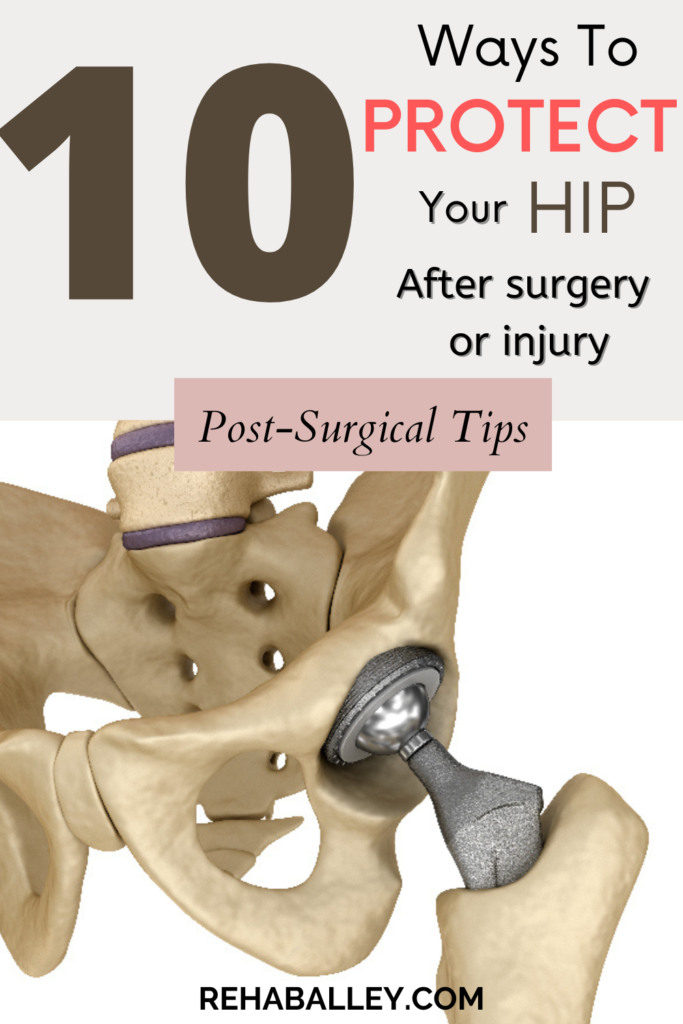
An article titled “Prevalence of Total Hip and Knee Replacements in the United States,” (LINK), estimated that 2.5 million individuals (1.4 million women, and 1.1 million men) received total hip replacements in the year 2010.
That number is expected to rise and shift to younger age groups.
The article also suggested that in spite of millions of people undergoing hip surgery each year, most people with hip surgery are very mobile and lead very functional lives.
Property of rehaballey.com
Hip replacement surgery can be an opportunity to regain your function and return to the activities you enjoy which is why I want to give you some tips on how to protect your hip after surgery or acute injury.
First, let’s discuss the main types of fractures that can occur, as well as common surgical techniques.
Hip Fractures and Surgical Techniques
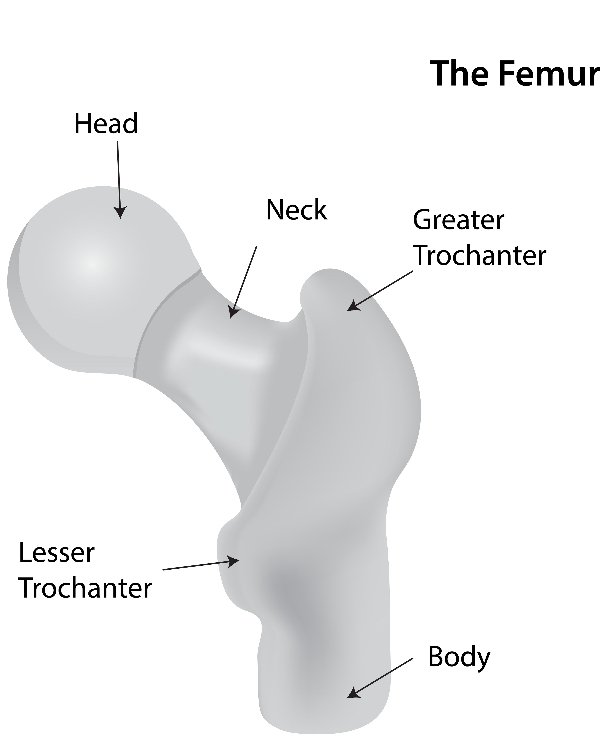
6 of the most common hip fractures that I typically see in the rehab setting include:
- Femoral neck fractures– These fractures occur about a few inches below the ball and socket joint. This is the part that connects the head of the femur (ball) to the rest of the femur bone (body).
- Femoral shaft fractures– This fracture occurs anywhere on the long shaft (body) of the femur bone that supports your thigh.
- Femoral head fractures– Femoral head fractures occur when you have a break in the head of the femur or the (ball) portion of the hip joint that connects to the (socket). These fractures generally occur traumatically as a result of hip dislocation.
- Acetabular fractures– The acetabulum is the (socket) part of the joint that connects the head of the femur (ball) to the pelvis. If you have a break somewhere in the socket part of the joint, you will be diagnosed as having an acetabular fracture.
- Intertrochanteric fractures– Intertrochanteric fractures are fractures that occur between the greater and lesser trochanters. The trochanters are raised portions of the femur that are positioned right after the femoral neck, and just before the femoral shaft.
- Pelvic fractures– The pelvic girdle connects your spine to your hip joints. A break anywhere in the pelvic bone is called a pelvic fracture. (most pelvic fractures a treated non-surgically).
In some cases, a doctor or surgeon may decide not to perform surgery and opt for more conservative treatments such as physical therapy. However, in some cases in order to improve your quality of life, hip surgery may be the best option.
Property Of Rehaballey.Com
The 4 most common types of hip surgery that I see in the rehabilitation setting include:
- Total Hip Replacement– This type of surgery involves the removal of both the ball and socket joints. These joints are then replaced with artificial implants or prostheses. This is the most common type of hip surgery. (Expect to be placed on anterior or posterior hip precautions).
- Hemiarthroplasty– During a hemiarthroplasty, the surgeon only replaces half of the hip joint, unlike a total hip replacement where the entire hip joint is replaced. Generally, the surgeon will replace just the head of the femur or the (ball) portion of the hip joint with a prosthesis or implant.
- Intramedullary nail (IMN)– Intramedullary nail is a procedure that uses a metal rod through the cavity of a bone to stabilize and support the fracture. An intramedullary nail is considered the “gold standard” for treating a femoral shaft fracture. (Most likely hip precautions will not be needed).
- Open reduction internal fixation (ORIF)– An open reduction internal fixation involves moving the broken pieces of a bone back into place using a surgical technique, followed by screws, plates, and rods to hold the fracture in place.
Now that you are familiar with the basic anatomy of the hip, common fractures of the hip, and surgical techniques, let’s dive into my top 10 ways to protect your hip after surgery or acute injury.
1. Follow Your Hip Precautions as Prescribed

Depending on the type of surgical technique used, the surgeon will place you on hip precautions. These precautions are primarily used to prevent hip dislocations and/or other fractures from occurring.
Hip precautions can also prevent excess pain, swelling, drainage, and other complications that can arise after hip surgery or injury.
Property Of Rehaballey.Com
There are many different types of hip precautions that the surgeon may place you on, depending on the type of surgery or injury. I
f the surgeon used a posterior or lateral approach, then you will most likely be placed on posterior hip precautions. Posterior hip precautions include:
- No hip bending past 90 degrees- (in other words, keep your knee joint lower than your hip joint).
- No twisting your hip inwards- (keep your knee facing forward, do not move your knee toward the inside of your body)
- No crossing your legs- (keep some space between your knees)
**ALLEY TIPS: Posterior hip precautions are the most common hip precautions used**
If the surgeon used an anterior surgical approach, then you will most likely be placed on anterior hip precautions, which include:
- No extending your hip backward- (this also restricts you from lying prone on your stomach, or bending backward to stretch your back)
- No twisting your hip outwards- (keep your knee facing forward, do not move your knee toward the outside of your body)
- No crossing your legs
**ALLEY TIPS: Depending on your surgeon and/or type of surgery your doctor may give you a brace or place you on stricter precautions, such as no hip bending past 60 degrees. Always speak with your doctor/surgeon to verify your hip precautions**
Property Of Rehaballey.Com
There are many different positions that you may not even realize, could be against your hip precautions.
For example, no hip bending past 90 degrees would also restrict you from bending down to pick up an object from the floor, or sitting in a chair that is too low to the ground…yes this also includes sitting in cars and other vehicles that are too low.
For this reason, I recommend using an SUV or a slightly taller vehicle. If your vehicle is too short, I recommend using pillows to elevate yourself in the seat, or reclining the seat back to adjust the angle of your hip to less than 90 degrees.
In addition, twisting your hip would also restrict you from reaching across your body to pick up an object from a nearby shelf or surface. Lastly, sleeping on the side of your surgery crosses your hip past the center of your body, which places you at risk for dislocations.
There are assistive devices that you can use to assist you with maintaining your hip precautions. Sleep position and assistive devices will be discussed in more detail in the sections below.
2. Follow Your Weight-bearing Precautions as Prescribed
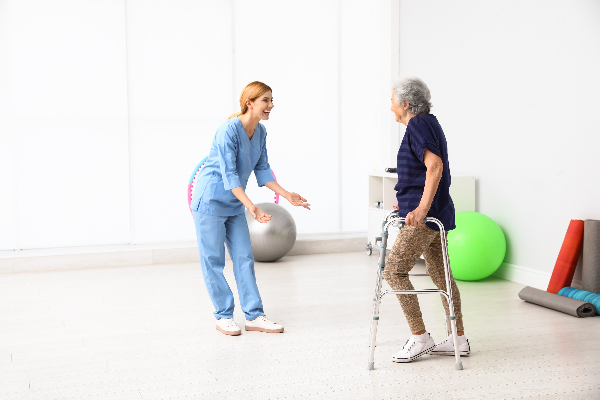
As discussed in my previous blog titled What is Partial Weight-Bearing? Common Weight-Bearing Restrictions Seen in A Hospital or Clinic Setting (LINK), the doctor may place you on weight-bearing restrictions depending on the type of surgery or injury.
The most common weight-bearing restriction is weight-bearing as tolerated (WBAT), which indicates that you can place as much weight on your limb as you can tolerate.
There are times when the doctor or surgeon will order partial weight-bearing restrictions, limiting the amount of weight you can place through your limb (ie: no more than 50 lbs, or no more than 50% of your weight).
Property Of Rehaballey.Com
In more extreme cases, the doctor may restrict you from placing any weight through your leg at all. Weight-bearing restrictions can be used to allow optimal healing for fractures, wounds, or surgical hardware.
Other factors that can determine your weight-bearing restrictions include age, type of surgery or injury, comorbidities, past medical history, and prior level of function. I discuss the different types of weight-bearing restrictions in more detail in the article link listed above.
It is important to talk to your doctor or surgeon regarding your weight-bearing restrictions. Generally, weight-bearing restrictions are kept in place for 6-8 weeks but can be longer or shorter depending on your overall healing.
During this time you will need mobility or assistive devices to help you function while you are restricted. I discuss walking aids and assistive devices in the next section.
3. Use a Walking Aide and Assistive Devices
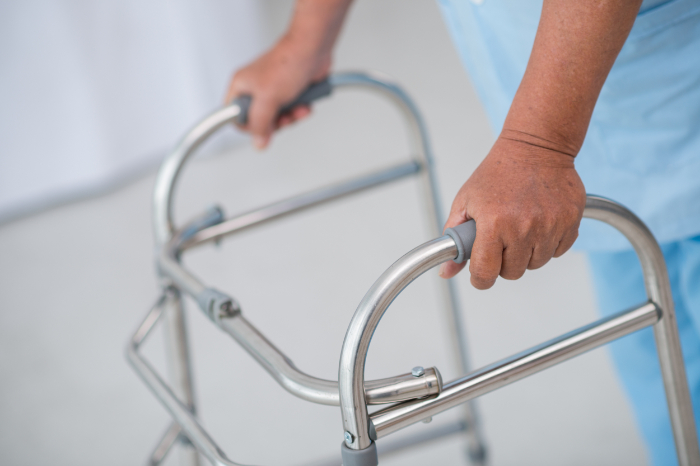
A walking aide will be necessary after surgery or injury, even if you were not previously using one. Walking aides assist with your balance, as well as keeping pressure off of your hip joint, and reducing pain.
If you have any weight-bearing restrictions, you will certainly need a walking aid to help you maintain your weight-bearing precautions.
The most common type of walking aid is a front-wheeled rolling walker (LINK). This walking aide is also the most stable and is recommended for individuals who are at increased risk for falling.
Property Of Rehaballey.Com
Other common types of mobility devices include four-wheeled walkers (with a seat), canes, and crutches. These types of assistive devices, however, are less stable and are only recommended for individuals who are at a lower risk of falling.
Depending on your prior level of function, you may have not been walking before your surgery, or are unable to walk very far. In this case, it is recommended that you purchase a wheelchair (LINK).
If you are unable to use your upper extremities due to a prior illness or injury, then a power chair (LINK) or scooter (LINK) is recommended.
Insurance companies will typically cover the cost of mobility devices as long as there is a need. Insurance companies will likely need a progress note from your doctor or therapist before covering a mobility device.
If you are unable to get coverage for a mobility device and would like one, you can refer to products (LINK) on my homepage for assistance.
**ALLEY TIPS: When using a mobility device, therapists and/or doctors will recommend the least restrictive device to promote optimal functional mobility. For example, a power chair is not recommended if you are able to walk. You should always be moving to the best of your capabilities**
In addition, assistive devices can help you with getting dressed, showering/bathing, or performing other activities of daily living. As mentioned in the paragraphs above, most doctors/surgeons will place you on hip precautions as a way of protecting your hip from further injuries and dislocations.
In most cases, you will be restricted from bending over to put on your socks or shoes, crossing your legs, or sitting on low surfaces.
Property Of Rehaballey.Com
Assistive devices will help you perform daily tasks while maintaining your hip precautions. Types of common assistive devices include:
- Reacher (LINK)
- Sock Aide (LINK)
- Shoe Horn (LINK)
- Leg Lift (LINK)
- Dressing stick (LINK)
- Long-handled bath sponge (LINK)
- Shower Chair (LINK)
- Transfer-Tub Bench (LINK)
- Hand Held Shower (LINK)
- 3-in-1 commode chair (LINK)
Dressing items can either be purchased separately or all together in the form of a hip kit (LINK). I recommend purchasing a hip kit because it is cheaper, and provides you with all of the necessary dressing equipment.
Some hip kits may also come with a variety of different-sized equipments, as well as extra items such as elastic shoe laces. These hip kits are very handy, and I recommend them to all of my patients after hip surgery.
It is important to note that dressing items and bathroom items are usually not covered by insurance companies. Therefore, these items will have to be purchased out-of-pocket.
Property Of Rehaballey.Com
There is good news, however, companies such as Health Products For You have a wide range of medical, therapy, and hospital products that you can order online at fairly reasonable prices. These companies also take HSA and FSA.
You can check out the product inventories by clicking products under my homepage (LINK). Furthermore, you can check out my blog titled Bathroom Equipment Ideas (LINK) to get more information on different types of bathroom equipment.
4. Use Ice to Manage Swelling and/or Pain

It is important to use ice to manage your swelling and pain after surgery. Ice helps to constrict your blood vessels which allow less fluid into the tissues, reducing inflammation and swelling.
Inflammation and swelling are normal immune responses after an injury or illness, and in some cases can occur throughout the entire limb.
However, if swelling is uncontrolled it can cause increased pain and stiffness making mobility and exercise more difficult. In addition, uncontrolled swelling can cause excess wound drainage.
I recommend icing your hip and leg for 15-20 minutes, every 2-3 hours to reduce swelling and inflammation. Other techniques that can help reduce swelling include elevating your leg on pillows especially when sitting upright, and performing gentle ankle pumps.
Property Of Rehaballey.Com
Avoid using heat during the early stages of healing because heat increases fluid into the tissues and may cause additional swelling.
If you have a condition known as Raynaud’s phenomenon or have sensory deficits such as with diabetes, you want to be very cautious when using ice.
Frequently check your skin for signs of white or bluish discoloration, which could indicate a lack of oxygen to your tissues.
It is also important to talk to your doctor or health care professional before using ice if you have these conditions. In extreme cases, it may be recommended that you avoid ice altogether.
In most hospital settings, a healthcare provider may issue an ice machine (LINK), or a gel ice pack (LINK). Ice machines and ice packs are very convenient because you get a more even distribution of ice to the injured area, and they contour to your leg more effectively.
Make sure to use a towel or covering over the ice machine or ice pack. Never place ice directly on your skin as this can cause skin damage, especially after prolonged use
5. Wear Shoes with Supportive Soles

Wearing shoes with supportive soles and good treads is also recommended after hip surgery or injury. As discussed in my previous blog titled “How to Protect Your Back After Surgery or Acute Injury” (LINK), wearing supportive shoes can reinforce support to your hip joint, as well as reduce your risk of falling.
As a physical therapist, I recommend tennis shoes that support your arches and enclose the entire foot. Avoid sandals, slippers, and shoes that easily slip off of your feet.
Property Of Rehaballey.Com
To avoid bending over to tie your shoes, use elastic shoelaces (LINK). These shoe laces allow you to put on and remove your shoes without having to tighten or undo the shoe laces. That’s right…the shoe laces stay in place, completely eliminating the need for tying.
For assistance finding the right shoe for your needs, I recommend Orthofeet. Orthofeet provides comfortable and biomechanically designed shoes for a variety of foot ailments and injuries such as, but not limited to, neuropathy, arthritis, diabetes, plantar fasciitis, calluses, Achilles tendonitis, and edema.
In addition, Orthofeet provides additional footwear and foot supports such as compression socks, insoles, and hands-free shoes that slip on and off without the need to bend over. Click HERE for additional information on Orthofeet.
6. Perform Exercises as Prescribed

There are a number of exercises that you can perform on a daily basis that can help strengthen your hip and improve healing. Although you may experience some pain, it is important to do your exercises and walk periodically.
This will help you achieve your full range-of-motion, and reach your optimal level of function after hip surgery.
Physical therapy or rehab is highly recommended after your hip surgery, as you will need help knowing which exercises to perform. A physical therapist will also make sure that you are performing the exercises correctly and maintaining any precautions that the doctor ordered.
Property Of Rehaballey.Com
During the early stages of healing, expect to need help with some of the exercises as you will not be strong enough yet to perform the exercises without assistance.
Some basic exercises that I recommend include:
- Ankle pumps– While laying on your back with your knees straight, move your ankle up and toward you then point your ankle down and away from you, repeat. (You can also perform this exercise while sitting upright in a stable chair).
- Heel slides– While laying on your back, take your surgical leg and slide your heel toward your bottom, bending your knee up, then slide your leg back down and repeat.
- Quad sets– While laying on your back with your knees straight, push your knees down toward the bed, hold for 5 seconds, then relax and repeat.
- Glut sets– While laying on your back with your knees straight, squeeze your bottom together, hold for 5 seconds, then relax and repeat. (You can also perform this exercise while sitting upright in a stable chair).
- Short Arc Quads– While laying on your back, place a pillow or wedge under your knee. Straighten out your knee (one at a time), while leaving the back of your knee on the pillow or wedge. Slowly lower your leg back down and repeat.
- Long Arc Quads– While sitting upright in a chair, straighten your knee by kicking your leg straight out in front of you. Slowly lower your leg back down and repeat
- Abduction/Adduction– While laying on your back with your knees straight, slide your leg to the side and then back to the middle. You can also perform this exercise while sitting upright in a chair with your knee extended out in front of you. (Be careful, some surgeons may restrict you from performing this exercise after surgery).
**Disclaimer: The exercises listed above are general exercise protocols after hip replacement surgery and is not intended for everyone. Make sure to talk to your doctor or therapist before starting any exercise regimen*
7. Eat a Healthy, Anti-inflammatory Diet

Most people fail to realize just how important it is to maintain a healthy diet, especially when you are healing from surgery or injury.
In most cases, systemic inflammation and pain can occur almost entirely from your diet even when there is no acute injury involved.
Furthermore, a poor diet often leads to inflammatory conditions such as arthritis, gout, and joint deterioration that can increase the need for hip surgery in the first place.
A good rule of thumb to remember is if the body does not recognize it, then it will treat it as a threat. Inflammation will occur and eventually, disease will develop if poor eating habits persist.
Property Of Rehaballey.Com
I continue to stress the importance of eating a healthy diet because I have seen first-hand how it completely changes my patients’ lives for the better. I have personally seen patient’s come off of all of their medications just from dietary changes.
There are many diet types including Vegan, Keto, Paleo, Whole 30, AIP, Carnivore, etc. These diets are designed to get you started with eating healthier by eliminating potentially problematic foods.
I am not a nutritionist, and therefore can not recommend specific types of foods; however, you generally want to eat as naturally as possible and stay away from highly processed foods.
Although everyone’s dietary needs are different, there are foods that are typically problematic for most people. These foods include:
- Gluten
- Soy
- Sugar
- Vegetable Oils
- Trans-fats
- High fructose corn syrup
- Genetically Modified Organisms (GMOs)
Listed below are examples of inflammatory vs. anti-inflammatory foods.
| Inflammatory Foods | Anti-inflammatory Foods |
| Sugar/Alternative Sweeteners | Dates, Honey, Maple Syrup |
| Wheat-gluten | Fish, Salmon |
| Refined carbs and grains | Organic Fruits and vegetables |
| Processed Foods/Fast Foods/Fats | Avocados and other monounsaturated fats |
| Vegetable oils/Cooking oils | Water/Steam, vegetable broth |
| Soy, corn, and other subsidized products | Nuts/Seeds (moderation) |
| Table salt | Herbs- ginger, garlic, turmeric, cinnamon |
| Heavily processed meats | Low processed Meats and Poultry (Grass-Fed) |
| Sodas/Processed Juice | Decaffeinated Tea, Natural Juice From Fruit |
8. Sleep with a Pillow Between Your Knees
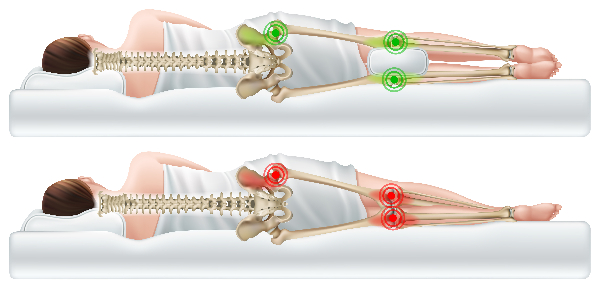
It is also important to consider your sleep position after hip surgery or injury. Most doctors and healthcare professionals recommend that you sleep on your back most of the time; however, you can also sleep on the side opposite of your hip injury.
For example, if you had right hip surgery or injury then you would sleep on your left side and vice versa. Avoid sleeping on your stomach especially if you have anterior hip precautions as this is contraindicated.
If you decide to sleep either on your back or on the side opposite of your hip surgery or injury, it is important to remember to place a pillow between your knees.
This prevents your hip from rotating inward or outward and also prevents you from crossing your legs while you are sleeping.
Property Of Rehaballey.Com
Avoid placing a pillow directly under your knee. Over time, this will decrease your ability to fully extend your hip joint limiting your range of motion.
For additional comfort, I recommend placing a pillow under your entire leg to reduce pain and swelling
9. Take pain medications as prescribed
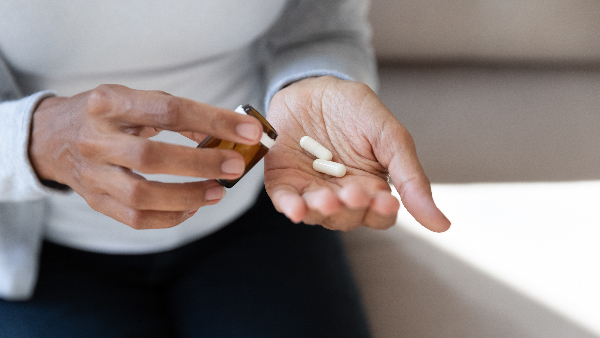
Most of you may have noticed that I am a strong supporter of natural medicine such as herbs/spices, fruits, and vegetables.
I personally believe that natural medicine is the safest way to heal and improve your function without negative side effects.
However, after surgery or injury, pain medications may be needed in order to keep your pain under control.
It is important to control your pain because this can greatly affect your ability to be able to sleep, exercise, walk, and function throughout the day.
Property Of Rehaballey.Com
Your doctor will prescribe the appropriate pain medication and dosage. If you decide to use pain medications as a form of pain management, it is important to follow the recommended dose and schedule.
Noncompliance can lead to severe side effects such as drowsiness, nausea/vomiting, upset stomach, liver/kidney damage, altered mental status, confusion, and addiction.
Try to time your medications at least 30 to 45 minutes before exercise or activity because it usually takes 30-45 minutes to take effect.
Patients who do not desire taking pain medications will often ask me if there are other alternatives to pain management.
The answer is yes; however, the effectiveness of these alternatives may differ from person-to-person. Some alternatives to pain management include:
- Ice packs, cold packs, ice machines (LINK)
- Pain patch (ordered by your doctor)
- TENS unit (do not place directly on or near the surgical site) (LINK)
- Heat pads (recommended only for arthritis or older hip injuries) (LINK)
- Rubbing cream ie: Biofreeze (do not place directly on the incision or surgical site) (LINK)
**ALLEY TIPS: Rehab Alley recommends talking to your doctor or other healthcare professionals prior to starting any pain management regimen. It is important to consider your specific conditions, precautions, preferences, and health needs*
10. Avoid extra stress on your hip
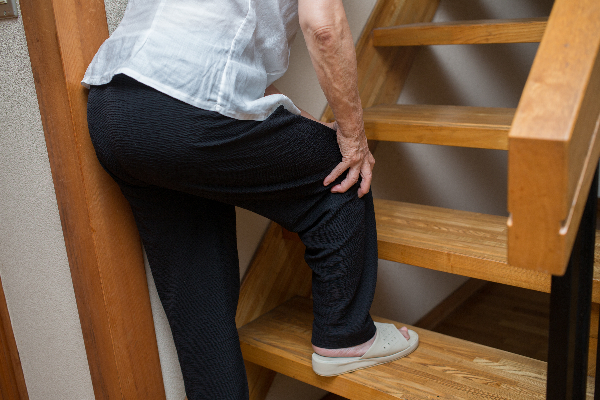
Lastly, it is important to avoid extra stress on your hip while you are healing. You are probably thinking, “well that’s easy, I’ll just rest and relax”, however, there are certain hazards that you may not be thinking about.
First, you want to avoid walking on rocky or extremely uneven surfaces. This may cause small rotations at the hip joint that can exacerbate pain and even cause dislocations.
It is important to receive training with a therapist or other healthcare professional before you attempt to walk on uneven surfaces by yourself.
Property Of Rehaballey.Com
Secondly, steps and stairs can be a daunting task and may be difficult to avoid at times. There is a certain technique when climbing stairs that will reduce pressure and stress off of your hip.
When going up the stairs, make sure to lead with your stronger leg first. With this technique, your stronger leg will absorb most of the force when going up the stairs.
When going down the stairs, however, lead with your weaker or surgical leg first. I know this sounds odd, but when going down the stairs, you need your stronger leg to help lower your weaker leg down the steps.
Make sure to use available handrails for your balance and climb stairs placing both feet on each step.
Make sure to avoid any excess squatting or bending especially if you are on hip precautions. In the previous paragraphs, I discussed the importance of using adaptive equipment to help you get dressed without having to bend over.
Property Of Rehaballey.Com
Some other important factors to consider are items in the kitchen or bathroom.
Make sure to place items that you use on a daily basis on shelves or surfaces that is easy to reach. Cookware and toiletries should be placed close to eye level to avoid bending, twisting, and reaching too far overhead.
Make sure to have someone help you place these items within reach if need be. To retrieve smaller items from the floor or higher surfaces, I recommend using a reacher (LINK).
As mentioned previously, do not reach across your body to retrieve items instead, use the hand closest to the item to avoid any twisting.
**ALLEY TIPS: For more active individuals avoid activities that involve excessive running, jumping, or pounding on the hip. Instead, I recommend activities such as walking, biking, and swimming.
It is important to note that with excessive running, jumping, and pounding activities your hip may last ~10-15 years before additional surgery may be needed.**
Property Of Rehaballey.Com
Hopefully, this article gives you some helpful tips to help protect your hip after surgery or acute injury. Using these tips will give you the greatest chance of reaching your optimal level of recovery.
If you have any additional questions please use my contact form (LINK), or email me at crumphs@rehaballey.com. I look forward to your inquiries and wish you well on the road to recovery. GOD BLESS YOUR ENDEAVORS!!
Resources
- American Academy of Orthopaedic Surgeons
- Prevalence of Total Hip and Knee Replacement in the United States.

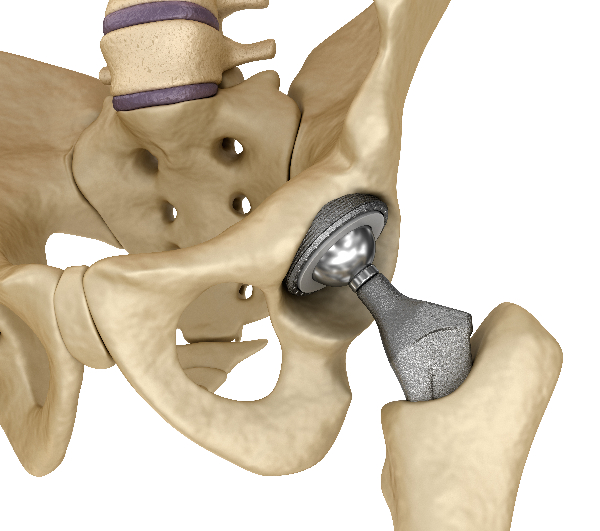
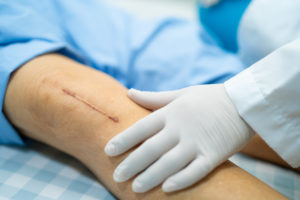
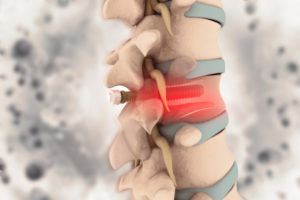
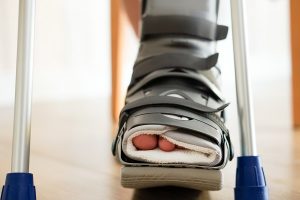
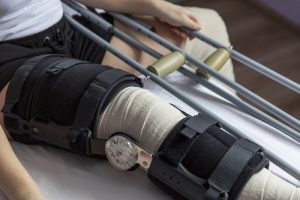
Hi there. Thank you for providing this great info. I recommend you adding the Direct Superior Approach which is muscle sparing and you do not have any post surgical restrictions. This is what I am having soon. The surgeon was adamant about not worrying about how I move or sleep but to listen to my body. Thanks for taking feedback.
Hi JJ Ols, thank you so much for the feedback. This technique is very interesting. I have actually never heard of this particular surgical procedure, and will certainly look more into this. I am always opened for new approaches and ideas.